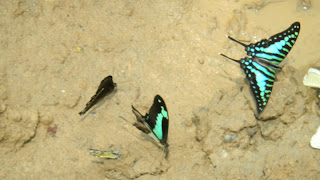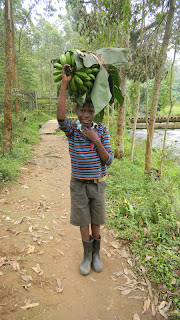This post marks the end of my African adventure for now; it has been an incredible journey.
But as all the best films end, here's hoping that there will be a sequel and an opportunity to return to Uganda some day.
Sunday, September 16, 2012
Entebbe Zoo
I spent my last day in Uganda in Entebbe and visited the Wildlife Education center (commonly known as the zoo) to see any animals I'd missed on safari at close quarters.
Hyena and rhino were two species I didn't see in the wild
The ostriches were surprisingly tall; their backs are at the same height as a zebra's.
I had a chance to see several monkey species at closer quarters - red tailed monkeys, colobus and chimps.
Wild vervet monkeys run amok through the zoo and are very entertaining to watch
Crowned cranes also fly in to join the caged animals (and for free food).
I also got a closer look at the lions and giraffes, and this friendly bushbuck.
Hyena and rhino were two species I didn't see in the wild
The ostriches were surprisingly tall; their backs are at the same height as a zebra's.
I had a chance to see several monkey species at closer quarters - red tailed monkeys, colobus and chimps.
Wild vervet monkeys run amok through the zoo and are very entertaining to watch
Crowned cranes also fly in to join the caged animals (and for free food).
I also got a closer look at the lions and giraffes, and this friendly bushbuck.
Kibale Forest Camp
We spent our last night on safari at Kibale Forest Camp in a tent with a bush shower that had to be filled with water heated on the fire - imagine a shower that smells like a cup of lapsang souchong tea! The toilet didn't flush with water but with sand so we called it our "litter box".
I sat on the verandah as the sun was setting and watched the monkeys leaping from tree to tree. I woke up in the night and through the open screen window, saw an animal grazing near the tent - I think it was a forest hog.
The rustic main building had a bar downstairs and a dining room upstairs - the food was excellent. We were woken with a cup of tea and a cookie brought to the tent.
I sat on the verandah as the sun was setting and watched the monkeys leaping from tree to tree. I woke up in the night and through the open screen window, saw an animal grazing near the tent - I think it was a forest hog.
The rustic main building had a bar downstairs and a dining room upstairs - the food was excellent. We were woken with a cup of tea and a cookie brought to the tent.
Butterflies
These butterflies were flocking to a puddle in the road in Ishasha, in the southern part of Queen Elizabeth National Park.
The forest at Kibale also teemed with butterflies
The forest at Kibale also teemed with butterflies
Primates at Kibale
The Kibale Forest National Park has the largest number of primate species of any Ugandan parks, including chimpanzees, baboons, vervet monkeys, colobus monkeys, grey cheeked mangabeys, red tailed monkeys and five others that we didn't see.
Red tailed monkeys scampered across the treetops surrounding the visitor center
On the way out of the park we found a tree full of grey cheeked mangabeys.
The highlight was the chimps. After a short walk into the forest we found a habituated family eating figs in the treetops.
Once chimp climbed half way down from the canopy but stopped to build a nest and sleep off his breakfast.
The noise the chimps made was incredible - here they were squabbling over the best place to sit and eat fruit.
Red tailed monkeys scampered across the treetops surrounding the visitor center
On the way out of the park we found a tree full of grey cheeked mangabeys.
The highlight was the chimps. After a short walk into the forest we found a habituated family eating figs in the treetops.
Once chimp climbed half way down from the canopy but stopped to build a nest and sleep off his breakfast.
The noise the chimps made was incredible - here they were squabbling over the best place to sit and eat fruit.
Friday, September 14, 2012
The Kingdom of Toro
Toro is the youngest of four traditional kingdoms in Uganda, having been created in about 1825 by one of the sons of the king of the Bunyoro. The king of Toro is called the Omukama and his palace was recently built in the capital of his kingdom Fort Portal with funding from General Gaddafi of Libya. Having been abolished by Idi Amin, the monarchies were restored by Museveni in 1993; the present Omukama ascended to the throne at only three years old.
This is a typical Toro basket woven from grasses; all the colors are natural.
Mosque in Fort Portal
The Fort Portal area is very beautiful; we passed fields of tea plantations and the tea pickers were hard at work plucking the leaf tips and tossing them over their shoulders into the baskets strapped to their backs.
Cows and goats on the way to Kibale Forest camp
This is a typical Toro basket woven from grasses; all the colors are natural.
Mosque in Fort Portal
The Fort Portal area is very beautiful; we passed fields of tea plantations and the tea pickers were hard at work plucking the leaf tips and tossing them over their shoulders into the baskets strapped to their backs.
Cows and goats on the way to Kibale Forest camp
Children of Kisoro
While we were in Kisoro, at Bwindi, we saw several children playing on these rustic home made scooters, which seem to be typical of the region.
This boy asked me to take his photo and then demanded "Give me a sweet!" We didn't have any sweets so he went away empty handed.
This boy asked me to take his photo and then demanded "Give me a sweet!" We didn't have any sweets so he went away empty handed.
Crater Lakes
Queen Elizabeth National Park contains a series of volcanic explosion craters, many of which have become crater lakes.
Bunyampaka is now used by local people for salt pans; the lakeshore is divided into plots that are flooded with water, which leaches salt from the soil as it evaporates. The salt is then scraped off the surface and sold.
This is Nyamanuka lake. Water buffalo were grazing at the water's edge
Here is Kikorongo lake, where Queen Elizabeth's 1954 visit gave the National Park its name. The Duke of Edinburgh returned here in 2009 to open a new visitor center.
We passed several more of the beautiful Ndali-Kasekende crater lakes as we drove out of the park through Kasese and past the Rwenzori mountains to Kibale National Park.
Bunyampaka is now used by local people for salt pans; the lakeshore is divided into plots that are flooded with water, which leaches salt from the soil as it evaporates. The salt is then scraped off the surface and sold.
This is Nyamanuka lake. Water buffalo were grazing at the water's edge
Here is Kikorongo lake, where Queen Elizabeth's 1954 visit gave the National Park its name. The Duke of Edinburgh returned here in 2009 to open a new visitor center.
We passed several more of the beautiful Ndali-Kasekende crater lakes as we drove out of the park through Kasese and past the Rwenzori mountains to Kibale National Park.
Birds at Queen Elizabeth National Park
We saw more birdlife in the savannah on our final game drive:
Brown snake eagle
Grey backed bush shrike
African white backed vulture with carrion
Grey heron
Red bishop (southern)
Additional birds seen this day included gonolek, blue naped mousebird, palm nut vulture, bustard, browed white coucal, crowned lapwing, saddle billed stork, white browed robin chat and a flock of red billed quelea.
Brown snake eagle
Grey backed bush shrike
African white backed vulture with carrion
Grey heron
Red bishop (southern)
Additional birds seen this day included gonolek, blue naped mousebird, palm nut vulture, bustard, browed white coucal, crowned lapwing, saddle billed stork, white browed robin chat and a flock of red billed quelea.
Subscribe to:
Comments (Atom)



















































